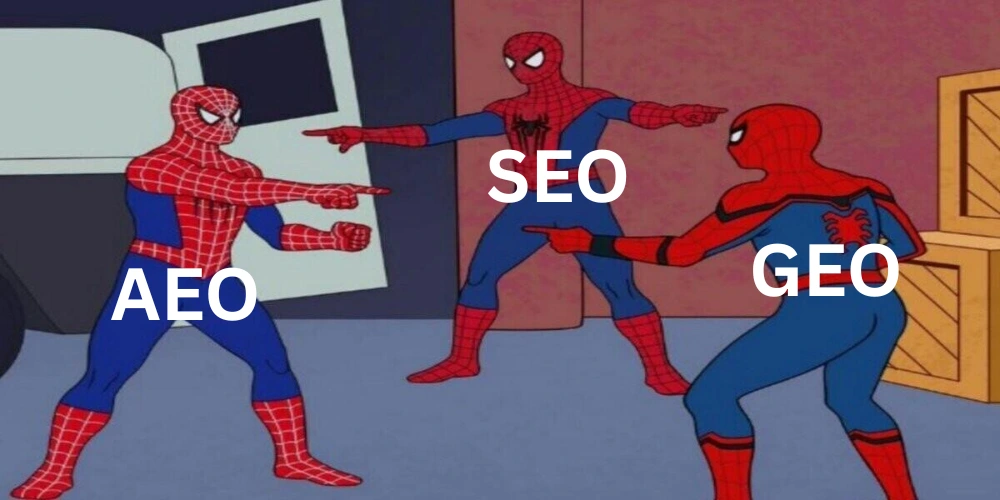What Are SEO, AEO & GEO? A Clear Data Driven Breakdown

Over the last few years, I’ve seen a big shift in how people search online. Honestly, it’s happening faster than most businesses realize. Traditional SEO is still important, no doubt. But with AI-powered platforms like ChatGPT, Perplexity, and Google’s new Search Generative Experience (SGE) stepping in, user behavior is changing rapidly.
Nowadays, people are no longer clicking through pages to find what they need. Instead, they’re getting answers instantly. In fact, according to Sparktoro, 60% of all searches end with zero clicks. That means more than half of your potential audience might never even visit your website.
This shift has made me rethink how we approach digital visibility. It’s not just about ranking high on Google anymore. To stay visible and relevant in this new landscape, we now need to focus on three layers of optimization:
- SEO (Search Engine Optimization)
- AEO (Answer Engine Optimization)
- GEO (Generative Engine Optimization)
Each one plays a unique role, and together, they shape the way our content shows up not just in search results, but inside AI-generated responses too.
What is SEO? (Search Engine Optimization)

SEO has always been the backbone of digital visibility. It’s the process of helping your website appear organically in search results without paying for ads.
And let’s be real, Google still dominates the game. As of May 2025, Google holds 89.57% of the global search engine market share according to StatCounter. Which makes it the #1 place we need to focus on for organic traffic. So, for any online store, blog, or local business, being visible in Google’s search results is a must.
What really excites me about SEO is how much impact it can create when done right. Look at Backlinko’s famous Skyscraper Technique 2.0. Brian Dean used it to boost organic traffic by 652% in only 7 days.
We have a blog about Brian Dean Thoughts on new SEO, check it out.
So yeah, SEO isn’t just a nice-to-have. It’s a powerhouse for growth when you understand how to use it the right way.
What is AEO? (Answer Engine Optimization)
Now here’s where things start to shift. AEO or Answer Engine Optimization is all about getting your content picked up by AI-powered platforms like ChatGPT, Google’s SGE (Search Generative Experience), or Perplexity. Unlike traditional SEO where the goal is ranking on the SERP, AEO focuses on being the answer the one the AI chooses to show or speak.
To do that, your content needs to be:
- Crystal Clear
- Concise
- Directly Answer User Questions
No fluff. No over-explaining. Just straight-to-the-point content that AI systems can easily understand and use. So if your content isn’t optimized to be that instant answer, you’re probably missing out to AEO.
What is GEO? (Generative Engine Optimization)
Now let’s talk about something that’s often misunderstood GEO, or Generative Engine Optimization. This isn’t just another version of SEO or AEO. It’s a totally different beast. GEO is about optimizing for how AI models like ChatGPT, Claude, Gemini, or Perplexity learn, process, and respond to content.
Instead of just focusing on search rankings or featured snippets, GEO looks at the backend of AI how language models are trained, what kind of sources they pull from, and how your brand shows up when someone asks an AI a question.
To get cited or mentioned by AI platforms, you need to build:
- Structured Content
- Include Factual Accuracy
- Create a Strong Digital Footprint through high-authority mentions, schema markup, and consistent branding.
In other words you need to make it ridiculously easy for AI to find, trust, and use your content as a source.
But GEO isn’t only about content visibility. It also refers to how we fine-tune and optimize the performance of generative AI models in enterprise environments – especially in industries like manufacturing, logistics, and healthcare.
So whether you’re trying to show up in AI answers or you’re actually building tools with AI. GEO is what helps you stand out and scale smart.
Key Differences: SEO vs AEO vs GEO
| Aspect | SEO | AEO | GEO |
| Main Goal | Rank higher in traditional search engine results | Get picked as the direct answer by AI/search engines | Be cited, referenced, or optimized within generative AI models |
| Target Platform | Google, Bing, Yahoo | Google SGE, ChatGPT, Perplexity, voice assistants | ChatGPT, Claude, Gemini, enterprise AI systems |
| Content Focus | Keywords, backlinks, on-page optimization | Q&A style content, concise answers, schema | Structured facts, credibility signals, context-rich data |
| Search Behavior Fit | Users clicking links to read more | Users looking for instant answers without clicking | AI systems summarizing and generating based on trusted data sources |
| Performance Metric | Organic traffic, keyword rankings, bounce rate | Featured snippet wins, voice visibility, AI visibility | Mention rate in AI outputs, gen speed, model efficiency |
| Use Case Example | Blog articles, service pages, product pages | FAQ sections, how-to guides, conversational answers | AI training data, enterprise content used for LLM learning |
Why You Need All Three in 2025
Here’s how I see it SEO is the foundation. If your content isn’t optimized for search engines, nothing else matters. You won’t rank, and AI won’t find you.
Once you’ve nailed the basics, that’s when AEO comes in. You can’t win in AI search (like ChatGPT or Google SGE) without solid SEO first. AI pulls answers from content that’s already well-structured, clear, and credible.
Then there’s GEO which is all about making sure AI models can reference and trust your content. But again, if you haven’t done SEO and AEO, GEO won’t pick you up either.
So for me, it’s not about choosing one. It’s about stacking all three – SEO ➝ AEO ➝ GEO. If you want real visibility in 2025 and beyond.
My Final Thought on SEO, AEO and GEO
At the end of the day, digital visibility isn’t what it used to be. It’s evolving so fast. SEO got us here, but AEO and GEO are where we’re headed. If we want to keep showing up in search, in voice, in AI responses, we have to stop thinking in silos and start thinking in layers.
From my experience, the brands that will win in 2025 are the ones that understand how to rank, answer, and be referenced all at once.
- Start with solid SEO.
- Build with smart AEO.
- Level up with strategic GEO.
That’s the stack. That’s the future.

